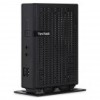ViewSonic SC-T45 SC-T45 User Guide M Region (English) - Page 79
Configuring Advanced View Connection Settings - default password
 |
View all ViewSonic SC-T45 manuals
Add to My Manuals
Save this manual to your list of manuals |
Page 79 highlights
Configuring Client Settings Configuring Service Access Settings 3.5.11 Configuring Advanced View Connection Settings The table below provides a description of each setting item for View connections. Please refer to this table to configure advanced settings and customize your SC-T45 desktop shortcuts for service access. General Sub-tab Server Settings Item Session Name Description Type in the name for VMware View sessions. Connection Server Type in the computer name or IP address of the View Connection Server. NOTE: For more information on View Connection Sever, please visit VMware website at www.vmware.com. Port Use secure connection (SSL) Login Settings Item Log in as current user User Name Password Domain Name Desktop Name Type in the port number used to communicate with the View Connection Server. To use the default value, simply leave it blank. Check/Uncheck to enable/disable secure connection. Description Check to log in VMware View services with the current user credentials. When checked, the User Name, Password, and Domain Name fields will be grayed out. Type in the user name for authentication. Type in the password for authentication. Type in the domain name of the View Connection Sever. Type in the desktop name. Or, leave it blank for users to select one. NOTE: If Manual is selected for the Display Protocol field below, this field will be grayed out. Click the drop-down menu to select the display protocol. Three options are available: Manual, Microsoft RDP, and PCoIP. Display Protocol Option Manual Microsoft RDP PCoIP Description Manually select the desired display protocol. Use Microsoft RDP as the display protocol. Use VMware PCoIP as the display protocol. 71















